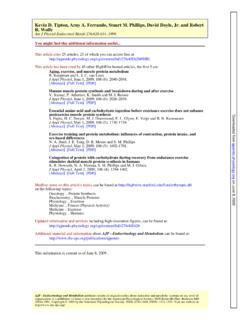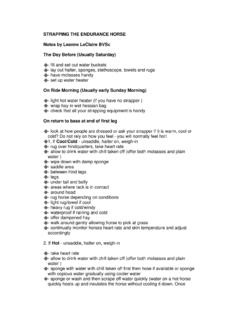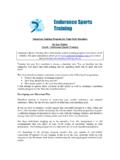Transcription of Neuromuscular adaptations to concurrent …
1 , , of Orthopedics & Rehabilitation, Kinesiology, and Radiology, University of Wisconsin-Madison, Madison, WIABSTRACTMcCARTHY, J. P., M. A. POZNIAK, and J. C. AGRE. Neuromuscular adaptations to concurrent strength and endurance Sports Exerc., Vol. 34, No. 3, pp. 511 519, :The purpose of this study was to examine muscle morphological andneural activation adaptations resulting from the interaction between concurrent strength and endurance :Thirtysedentary healthy male subjects were randomly assigned to one of three training groups that performed 10 wk of 3-d wk 1high-intensity strength training (S), cycle endurance training (E), or concurrent strength and endurance training (CC).
2 strength ,quadriceps-muscle biopsies, computed tomography scans at mid-thigh, and surface electromyogram (EMG) assessments were madebefore and after :S and CC groups demonstrated similar increases (P ) in both thigh extensor (12 and 14%)and flexor/adductor (7 and 6%) muscle areas. Type II myofiber areas similarly increased (P ) in both S (24%) and CC (28%)groups, whereas the increase (P ) in Type I area with S training (19%) was also similar to the nonsignificant (P )increase with CC training (13%). Significant increases (P ) in maximal isometric knee-extension torque were accompanied bynonsignificant (P ) increases in root mean squared EMG amplitude of the quadriceps musculature for both S and C groups.
3 Nochanges (P ) in the EMG/torque relation across 20 to 100% maximal voluntary contractions occurred in any group. A small 3%increase (P ) in thigh extensor area was the only change in any of the above variables with E :Findingsindicate 3-d wk 1concurrent performance of both strength and endurance training does not impair adaptations in strength , musclehypertrophy, and neural activation induced by strength training alone. Results provide a physiological basis to support severalperformance studies that consistently indicate 3-d wk 1concurrent training does not impair strength development over the short Words:HYPERTROPHY, MUSCLE FIBERS, CT SCAN, EMG, RESISTANCE EXERCISES trength and power development has been impairedwhen endurance training is added to strength training(4,11,21 23,25).
4 Other investigators, however, reportno interference in strength development with concurrentstrength and endurance training over a short term(1,14,27,31,34,38). Studies investigating the interaction ofthese two diverse types of training, however, provide strongevidence that concurrent training does not impair endurancedevelopment as measured by maximal aerobic power(21,22,25,27,34). It thus appears, that with concurrentstrength and endurance training, the major consideration isthat of endurance training possibly interfering with the neu-romuscular system s ability to generate maximal a considerable number of studies have ad-dressed performance adaptations with concurrent training,only a few have attempted to address underlying physiolog-ical mechanisms responsible for impairment in strengthdevelopment.
5 Muscle hypertrophy and changes in motorunit recruitment are two of the most salient factors associ-ated with strength development (16). Kraemer et al. (25)indicate an impairment in hypertrophy of Type I fibers whenendurance training is added to strength training. Bell et al.(4) reported no increase in Type I fiber area with concurrentstrength and endurance training, but there were no differ-ences in fiber type area adaptations (both Type I and II)compared with the same type of strength training performedalone.
6 With concurrent training, Nelson et al. (31) reportedhypertrophy in Type I, IIa, and IIb fibers, whereas thestrength-only training employed in this study resulted inhypertrophy of only the Type IIb fibers. None of thesestudies considered muscle adaptations at the macroscopic orwhole muscle level as may be assessed with imaging tech-nology. Sale et al. (34) reported similar muscle area in-creases with both strength -only and concurrent training asmeasured at both the microscopic (Type I and II fibers) andmacroscopic (quadriceps area as assessed using computedtomography) levels.
7 It is evident that the pattern of specificfiber type hypertrophy with concurrent training is inconsis-tent in the few investigations addressing this question andlittle is known about adaptations at the whole muscle level(26).With strength training there are several different lines ofevidence that indicate adaptations within the nervous systemoccur that are related to strength development (33). One ofthe major areas of investigation with strength training fo-cuses on adaptations in motor unit activation in prime mov-ers as measured by electromyography (EMG) (30,33).
8 Theintegrated EMG signal attained during a maximal isometriccontraction has been shown to increase in several longitu-dinal strength -training studies (16,17,29), although otherinvestigations report no change in this measure(13,30,37). It has been suggested that an impairment in0195-9131/02/3403-0511/$ & SCIENCE IN SPORTS & EXERCISE Copyright 2002 by the American College of Sports MedicineSubmitted for publication January for publication July development with concurrent training, as compared withstrength-only training, may be related to altered neural activa-tion associated with maximal voluntary contractions (6,25,26).
9 The relatively small number of maximal or near maximalcontractions involved in strength training demand differentpatterns of motor unit activation than the fairly continuous lowlevel contractions involved with endurance training. No studiesto date have investigated the effects of concurrent training onneural activation of prime investigate major mechanisms associated with changesin strength performance, the purpose of this study was toevaluate the influence of 3-d wk 1concurrent strength andendurance training on muscle morphology and neural activa-tion in previously sedentary individuals.
10 We tested hypothesesthat the diversity of demands of traditional endurance andstrength training on skeletal muscle would limit muscle hyper-trophy at the macroscopic (whole muscle) and microscopic(myofiber) levels. In addition, we tested the hypothesis thatconcurrent-training adaptations are different than any changesthat may occur with strength -only training in neural activationof and experimental data werecollected as part of a larger study that also examined theeffect of concurrent training on body composition, V O2peak,and strength performance (27).







